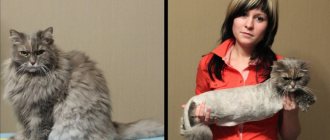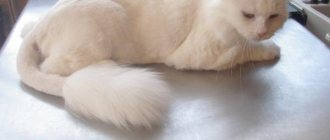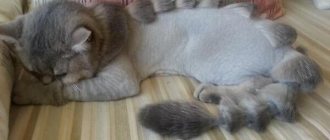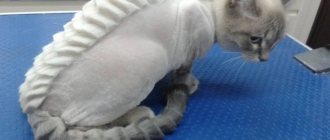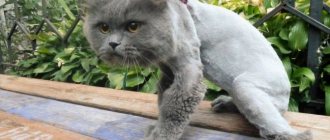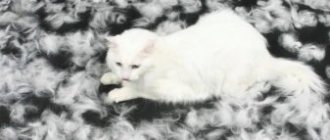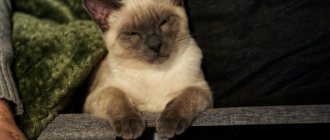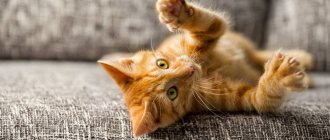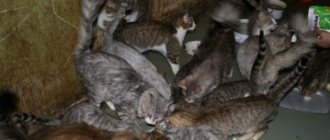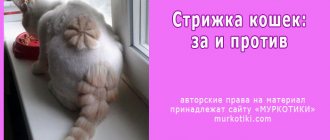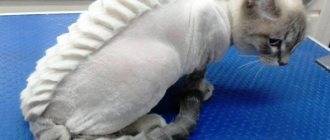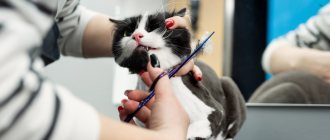Grooming a cat is a specific procedure that most owners prefer to entrust to a professional. However, it is not always possible to find a suitable master or pay him for the work. In some cases, you need to quickly cut your cat’s hair, and you don’t have time to go to a salon, so you have to think about how to carry out the procedure yourself. What are the features of grooming cats at home?
Why cut your cat's hair?
After clipping, the coat is easier to comb.
In fact, the procedure is quite popular and in demand in grooming salons. Yes, there are owners who bring their favorite furry dogs for a haircut in order to win at the exhibition, have an extravagant look and have cute photos for Instagram or social networks.
But there are also those who know that such hairstyles have many advantages for the health of their children. What are the advantages of a unique hygiene procedure?
- getting rid of tangles, which have become too numerous and can no longer be untangled with ordinary brushes;
- normalization of digestion: unsightly and hanging hairballs, disfiguring the cat, can cause blockage of the stomach and intestines if accidentally swallowed during another lick;
- order in the house: after a haircut, the wool does not lie everywhere and does not cause the owner to have bouts of quiet rage when, once again, black pants have turned into a shaggy hedgehog;
- easier combing;
- peace of mind between the cat and the person: you won’t have to tyrannize your pet and freak out from the daily tearing apart of tangled areas of fur;
- relief from suffering: in summer the animal will no longer suffer from the heat.
By the way, the presence of tangles is the cause of dermatological problems: the skin under them heats up more, creating favorable conditions for the development of pathogenic microflora. Frequent formation of “felt balls” indicates a metabolic disorder or vitamin deficiency and requires consultation with a specialist.
What to expect after a haircut
Despite the benefits of grooming for cats, especially those with thick, long hair, there are also negative consequences of this procedure. These points are mainly associated with changes in the structure of the coat. Thus, in tipped and colorpoint breeds, the coat that grows back after trimming becomes two or even four shades darker.
After being trimmed, cats' fur grows back slowly and may never reach its original length.
It is also important that after machine processing of cat fur:
- the fur coat may become thinner and shorter;
- the hairs in the first week after cutting (especially with a 1 mm length nozzle) will be hard and prickly;
- the likelihood of skin damage increases (during playing or scratching, after a long stay in the sun).
In my opinion, grooming a cat is a tedious procedure not only for the owner, but also for the animal. Therefore, it is better not to experiment with your pet unless unnecessary. Being the owner of both long-haired cats and medium-length purring cats, I have always limited myself to thorough combing. With proper care, machine treatment of a pet is not so necessary and is a last resort. And exotic lovers would do well to pay more attention to the psychological comfort of their pet. After all, curly haircuts take a lot of energy from a cat. For mobile or too independent “touchy people”, I would rather not change their image at all.
Features of grooming cats of popular breeds
Certain breeds of cats have their own specific haircuts. Here are examples of some of them.
British Shorthair
The British have naturally short, silky hair that is not prone to matting, so experts generally do not recommend cutting representatives of this breed. However, if the cat is provided with proper and correct coat care in the form of regular combing out of excess fluff with rubber or bristle brushes, it will have an attractive appearance without any hairstyle.
The British do not require a haircut if properly cared for.
Persian
Persian cats have long and fluffy hair, which quickly forms tangles. That's why they need the services of cat groomers the most. Cats of this breed have an easygoing nature, but do not tolerate the grooming procedure very well. It is necessary to trim such cats together with an assistant, especially if this procedure is being done for the first time in her life. The classic hairstyle for Persian cats is “Puss in Boots.”
Siberian breed
For representatives of the Siberian breed, haircut options can be any; these cats cannot be spoiled by outlandish hairstyles. The structure of the fur of Siberian cats is very similar to human hair, and the more often and shorter it is cut, the better quality it becomes. The most popular haircuts for this breed are French Lion, Dragon and Plush.
Siberian cats are beautiful with any hairstyle
To cut or not to cut
It is important to understand that not all cats can and should be subjected to this procedure. So the following are a kind of contraindication:
- colorpoint and tipping colors - as the fur grows on the back and belly, it will become several tones darker than before cutting;
- disgusting character and violent temperament, when the animal does not give in to any persuasion. Of course, you can cut it under anesthesia, but in this case, evaluate all the possible risks associated with the administration of narcotic drugs: cardiac arrest, coma, failure of the liver and kidneys. As a last resort, sedatives and muscle relaxants are used instead of drugs, but only after approval of the appropriateness of their use by a specialist and under his clear guidance;
- Without an urgent need, there is no point in cutting short-haired cats - the heat does not particularly interfere with normal life activities, and they never have mats;
- Smooth-haired animals are cut only in extreme cases, for example, when they have been worn in oil paint and it is easier to shave the animal than to try to rub off the matted multi-colored wool.
Which cats should not be cut?
Owners of colorpoint and tipping cats are often interested in the question of whether their pets can be cut. This procedure will not affect their health in any way, but if the cat is a breeding cat, then it should be taken into account that after the haircut, the hair that grows back on the back and belly will be several tones darker.
Animals with a violent temperament that are not amenable to persuasion should not be cut unless absolutely necessary. The same applies to short-haired pets. They are not bothered by the heat, the fur does not tangle, so only if the cat gets very dirty, for example, with oil paint, is it easier to trim it than to wash it.
What breeds of cats are prohibited from being cut?
Some types of breeds are not recommended to be cut. These breeds include:
- shorthair (British, Scottish fold). There is no particular point in cutting them, only if absolutely necessary. However, there are long-haired types of these cats, namely British Longhair and Highland Fold, they need to be cut;
- cats with tipping or color-point color. After cutting, the color of the coat changes (it becomes darker);
There are cat breeds that don't need grooming services.
- semi-long-haired breeds (Siberian and Norwegian forest cats, Maine Coon). They do not need a haircut; in their case, you can limit yourself to only bathing and thorough combing.
Tools and accessories
To groom a cat at home, you need to be patient and prepare the necessary equipment in advance. The less fuss and emotions there are, the calmer, faster and without incidents everything will go. So what might you need?
- assistant,
- special trimmer for cats (regular and for hard-to-reach places),
- rounded scissors with blunt ends, it is best to take surgical ones,
- In case of possible injury, prepare peroxide, cotton wool, and brilliant green.
The requirements for the trimmer are:
- quality and reliability;
- power of at least 45 watts. It is especially important to observe this point in relation to Persians, exotics and other owners of luxurious hair with thick undercoat;
- for other breeds, less powerful devices are also suitable;
- sharp blades that actually cut rather than tear out fur;
- the length of the blade is from 2 to 3 cm, otherwise you can accidentally injure the skin, especially if the haircut is carried out by an inexperienced user;
- the device must operate from the network, which guarantees its stable operation without interruption or loss of power;
- It is better if the motor is rotary rather than vibrating. Although this is not important, especially if the cat is cut from time to time.
Instead of an electric unit, you can use the most ordinary mechanical machine. It has a number of advantages:
- lower price,
- absence of unpleasant noise, and therefore the animal will be less nervous,
There are also some disadvantages: the hairstyle may turn out to be asymmetrical, and the process will be lengthy.
In principle, you can trim a cat’s hair at home with simple scissors, especially if you only need to cut off tangles or shape individual areas of the body.
Which machine is recommended to choose for grooming a cat?
There are a huge number of professional tools for grooming furry pets. Don't save money and buy the cheapest one. Because an inexpensive trimmer will painfully pull out hairs or burn delicate skin, in addition, such models quickly become unusable.
Choose the right clipper for your cat
To remove hairs in hard-to-reach places, it is best to choose a small trimmer whose blades do not exceed two centimeters in length.
A powerful machine with wide blades, which can remove even balls of matted wool, is suitable for thicker fur coats. The power of the device, for example, for Persian breeds should be 45 W or more. Machines with less power simply will not cope with thick hair; they will overheat and break during the first procedure. An important point is that the trimmer is as quiet as possible.
Preparing a cat for immobilization
There is a really workable option to immobilize a cat with a clothespin or a paper clip - essentially the same thing. The item is attached to the withers without causing pain or discomfort for the cat. Behavior is inhibited spontaneously and reactions are slowed down. The cat will better tolerate this procedure, provided that it is performed by a person close to him, or better yet, by the owner. Also, manipulation should be carried out only in case of urgent need, and not for fun. Most cats that were tried to be immobilized in this way experienced the action positively, without pain or fear. But no one is immune from the individual reaction of each individual cat.
First you need to prepare the cat for the procedure:
- If the pet is wearing a collar, it must be removed to provide free access to the cat's neck. If left on, it can create a suffocating feeling and your pet will become agitated.
- After this, you need to find the scruff. It is located on the outside of the cat's neck and looks like a loose fold. If it is difficult to feel the cat’s scruff, then it will not be easy to immobilize it. You should be extremely careful not to squeeze your cat's skin too hard.
- You need to grab the scruff of the neck with your hand and look at the pet’s reaction. If he feels completely relaxed, then he can quickly be immobilized. If the animal meows or tries to escape, then you need to try to immobilize it using another method.
You can determine that a cat is tense when he is not trying to escape by dilated pupils, intermittent breathing, and moving ears. If you grab it by the scruff of the neck closer to the ears, you can control the movement of the animal’s head. To avoid needing help when immobilizing a cat, it is better to watch a training video in advance. It's actually simple.
© shutterstock
How to carry out the procedure
The hair on a cat's head is usually not cut.
- The cat is fixed on its side by its hind and front legs.
- If the animal is overly aggressive, a collar is put on the animal to prevent it from biting.
- First they cut the tangles with scissors, and then take the clipper and continue working on the sides and back.
- The fur on the paws is removed last, if necessary at all.
- When working in the abdominal area, exercise maximum caution and carefully avoid the nipples and intimate area. It is better to cut the area around with scissors in advance so that all the delicate parts are clearly visible.
- The hairstyle is not done on the head; in extreme cases, it can be shaped using thinning scissors.
- The tail is cut at will and as the hairdresser's imagination allows.
It is important to carry out all manipulations as carefully as possible so as not to injure the animal. It is not always possible to completely trim an animal at once - do not be upset: even though the procedure will take place in several stages, but all participants in the “acting” will remain safe and sound.
After grooming, the cat should be washed and dried with a hairdryer. Although, to avoid unnecessary stress, you can simply wipe your pet with a damp cloth or suede cloth to remove cut and stuck hairs.
In the cool season, the trimmed miracle needs to be provided with a comfortable indoor microclimate without drafts and the possibility of hypothermia.
Tips for owners
Before grooming your cat at home, remember these important points:
- The nipples, genitals and anus should be trimmed very carefully, holding the cat firmly to the table.
- After a haircut, your pet may change the structure, color and length of its coat.
- You cannot trim your head, mustache or ear hair. If you want to give a neat look to the mane on your head, use thinning nails. Don't remove all the hair from the tail, mostly leave a tassel or whisk at the end.
- Stretch the cat's skin to avoid damaging it.
- You need to comb your cat after grooming with a special fur brush. Afterwards, wash your pet or wipe it with a damp cloth.
- Observe your pet's behavior for several days after the procedure. If you see any alarming changes, consult your veterinarian.
- It is necessary to cut your cat's hair no more than three times a year, as the fur grows back slowly.
shave yourself, cut it with scissors or a clipper, which is better to do it and what happens after
Grooming domestic cats is not a mandatory hygienic procedure, but nevertheless, many breeds need to have their fur shortened. A step-by-step method on how to trim a cat’s hair at home will be useful for many owners, because it is not always possible to have the procedure done by a veterinarian. This procedure can be carried out for hygienic and decorative purposes, and can also be prescribed by a veterinarian as a treatment.
Read in this article
Reasons for cutting a cat's hair
There are several good reasons why pet grooming is necessary and desirable.
procedure. According to their purpose, haircuts for domestic cats are:
- Hygienic . This procedure is carried out if the wool is tangled and tangles have formed in it. Often the animal can become very dirty. Contaminants such as paint, varnish, building materials (plaster, cement, glue, etc.) cannot always be removed with water and shampoo. In this case, only trimming the wool will help.
- In some cases, hygienic haircuts are resorted to in old and sick animals that are unable to care for their coat. This hairdressing procedure is performed to avoid the formation of hair balls in the stomach. This is especially important during hot periods to avoid overheating of the animal.
- With prolonged molting, such a hairdressing procedure can make it easier to maintain a pet.
- Medicinal . A veterinarian can prescribe a haircut for certain diseases. Indications for the procedure are the following diseases: parasites (fleas, lice), dermatitis, infectious skin diseases, hyperplasia of the sebaceous glands). Clipped wool makes it possible to more effectively treat the skin with medications and significantly reduces treatment time. There is nothing complicated about how to shave a cat for medicinal purposes.
- Decorative or fashion haircuts. This type of hairdressing in relation to a domestic cat is a whim of the owner, nothing more than a tribute to fashion. Through an original haircut, the owner expresses the characteristics of the cat's character, disposition, and individuality.
- Exhibition . A special haircut that is carried out to give the animal its shape to breed standards.
The best quality haircut is, of course, done in a salon. Grooming specialists use special tools and devices that do not damage the skin. But it will be useful for the owner to know how to cut a cat’s hair at home, so as not to overpay every time.
To see how cats are cut in a salon, watch this video:
How often to carry out hairdressing procedures
The regularity of haircuts is determined by the intensity of hair growth. As a rule, fur grows back from 3 to 6 months. The rate of fur growth is affected by the breed of the animal, its age, and state of health.
It is recommended to cut the average cat no more than 2-3 times a year. If the procedure involves removing tangles, then it is carried out as they form. Model haircuts can be done more often, but you should take into account the condition of the coat, the season of the year and the health of the pet. Hygienic and therapeutic haircuts are usually carried out as needed.
We recommend reading about how to stop a cat from scratching wallpaper and furniture. You will learn about the causes of property damage, methods that help preserve furniture, such as scratching posts, nail trimming, anti-scratch treatments and others. And here is more information about how to accustom a cat to a scratching post.
Some nuances that may arise after a haircut
Owners are often interested in what will happen if they cut their cat’s hair, especially for the first time. Fans of cat hairstyles should know that after cutting the coat, not only the structure of the coat often changes, but even the color. Pets with colorpoint and tipping should not be cut due to darkening of the fur in the belly and back.
a) Color point color variation; b) Solid blue color with a distinct silver tint (the ends of the hair have a silver tipping) Regular trimming may result in the coat not growing back to its normal length. After hairdressing procedures, the new fur coat may become thinner and quickly become tangled.
The consequences of cutting your own hair are often skin injuries. The risk of developing inflammatory processes increases.
When grooming in a clinic or salon, the animal is often given light anesthesia or sedatives. However, regular use of sedatives and anesthesia adversely affects the health of the pet.
What is needed for the procedure
Before being puzzled by the question of how to cut a cat’s hair himself, the owner should stock up on the necessary equipment and tools. For home grooming, you will need a high, stable table on which you can comfortably place the animal. A wide ironing board will also work for these purposes.
As a hairdressing tool, you need scissors with non-sharp edges and a clipper. Owners who are mastering home grooming are often interested in how cats are cut in the salon and at home. There are many cat trimmers available on the market. There is a tool designed specifically for cutting long-haired breeds. It is distinguished by sharpening of the blades and does not injure the delicate skin of the animal.
If your pet is terrified of electric clippers, it is better to use scissors or a manual clipper. Care should be taken when working, as the risk of injury from such a tool is high.
To comb the fur while cutting, you will need a comb. For this purpose, it is better to purchase a rare comb. All instruments must be individual. Before the procedure, it is advisable to treat the cutting surface with any disinfectant solution.
It is impossible to carry out high-quality independent grooming of your pet without an assistant.
You can purchase a special collar that protects the owner from bites from an unhappy pet.
It is better to have a restless cat groomed at a veterinary clinic, where she will be given sedatives if necessary. You cannot use any sedative medications at home.
Before trimming your cat's fur, you should stock up on disinfectant solutions, for example, hydrogen peroxide, chlorhexidine, to treat possible cuts.
How to cut your hair correctly
Before hairdressing manipulation, the animal should be bathed with shampoo and conditioner. It is best to carry out the water procedure 2 - 3 days before the haircut. This will make combing and the process of creating a hairstyle easier. To avoid injury, you should also trim your nails or wear special protective pads on your claws.
It is necessary to carry out a haircut with an assistant. How to cut a cat’s hair with a clipper has its own rules, the implementation of which will greatly facilitate the owner’s task:
- Using a machine, hair is removed from the sides, back and belly of the pet. As a rule, nozzle No. 3 is used, which corresponds to 3 mm. The abdominal area should be treated especially carefully. It is better to pre-cut the area of the perineum and milk nipples with scissors.
- Trim the hair in the armpit area, changing the nozzle to 2mm. Then the back of the body is cut.
- The tail is either not cut at all, or a “tassel” is left at the end.
- The hair on the paws is trimmed, forming either short “socks” or longer “socks”.
- If necessary, the hairstyle on the head is shaped using scissors.
- Use scissors to trim the mane and the “tassel” on the tail.
If you have to decide how to cut a cat’s hair with scissors, if you don’t have a clipper, then in this option you should prepare for a little more difficulty. With the help of scissors, as a rule, the wool is corrected after cutting with a clipper. The hairstyle, when using this one tool, will be uneven and unaesthetic.
After grooming, the animal must be bathed, wiped with wet wipes and dried with a hairdryer.
To learn how to cut a cat's hair at home, watch this video:
Popular hairstyles
The imagination of the owner and the professionalism of the grooming specialists make it possible to give the animal a wide variety of images: from a majestic lion to a creative Dragon-dinosaur. The most common and popular haircuts among cat owners are: Lion, Puma, exhibition haircuts Harlequin, Modern, Continental.
French lion
This type of haircut can be called universal, since it is often used for hygienic purposes and as a fashion hairstyle. It is advisable to choose this option in the hot summer. There are not many difficulties in how to cut a cat’s hair with a lion clipper yourself. The fur is cut using a tool over the entire body. The fur on the limbs is left unchanged in the form of “socks” or “golf”. The base of the tail is cut off, and a “tassel” or “broom” is formed at the end.
The Dragon
Exotic Dragon haircut is an unusual mohawk on the back of the animal. To give the pet an original look, the head is not cut, the fur coat on the body is trimmed. Along the spine and tail, the fur is clipped in the form of triangles. You can also leave scraps of wool and other shapes, it all depends on the imagination of the owner and the professionalism of the groomer.
Exhibition types of haircuts
Haircuts such as Harlequin, Modern, Continental are usually given to show animals. If the animal takes part in an exhibition, then the cats are cut in this case, as if for a fashion show. The purpose of such procedures is to emphasize the exterior features of the animal and, if possible, hide existing shortcomings. The owner will not be able to create such hairstyles for a pet on his own. This complex grooming requires experience and a professional approach and can only be performed by a master in a specialized salon.
A cat owner can do the grooming of a pet for medicinal and hygienic purposes himself. To do this, you need to know certain rules and be patient. Exhibition and decorative hairstyles are best left to professionals.
zootvet.ru
Popular cat haircuts
There are exhibition and home haircuts. The following hairstyles are ideal for home use:
- lion - all hair is cut off except the head, the tip of the tail and the paws below the “knees” and “elbow”,
- puss in boots in this case leaves fur on the head, tail and the entire surface of the limbs,
- summer
Exhibition or model hairstyles are created by experienced groomers. There are many options for “laying”:
- continental,
- puma,
- harlequin,
- modern,
- the Dragon.
If your plans do not include a cat grooming or the animal stubbornly does not give in to the hairdresser’s onslaught, then you will have to monitor and care for the fur as usual:
- periodic combing,
- timely removal of matted hairs,
- the use of shampoos and conditioners that help soften and straighten the hairs.
Long-haired breeds must be given special products that dissolve tangles in the stomach or use ready-made food that already contains the necessary absorbable ingredients. And to prevent heat stroke, you will have to get an air conditioner.
Well, a video on the topic of how cats are cut in salons:
How to cut a cat's hair: types of haircuts
If you are wondering how to cut a cat's hair, then the easiest option is to simply shorten it, with a clipper, for example. But there is a choice of different curly haircuts, which are chosen taking into account the type of wool, thickness, and breed of the animal. This factor is very important at exhibitions. A haircut will provide an original look for your pet and reflect its individuality.
Several types of popular cat haircuts:
- "A lion". The hairstyle involves cutting the entire back and the upper side of the legs, and the tail at the base. In this case, the head remains intact, as does the neck - a kind of “mane” is formed, as is a tassel at the tip of the tail. The tail can be shaped like a pom-pom, herringbone, or panicle. You can achieve the squirrel tail effect. The “socks” on the feet are made short or in the form of “gloves”.
Haircut "Lion" imitates the king of beasts
- "Puma." The haircut is similar to the “Lion” one, but the shirtfront remains in the chest area, which looks beautiful.
- "The Dragon". Here the sides and belly are trimmed until smooth, leaving the fur along the ridge and tail, giving it the shape of a fluffy comb with incisors.
Cat in the form of a dragon
- "Puss in Boots". To replicate the image of a fairy-tale hero, the hair on the back is cut short, the paws are trimmed on top, so that there are neat and identical “boots” below.
How does haircut affect animals?
Is it possible to cut a cat's hair without causing any changes, and how will cutting it at home affect the pet's behavior?
Haircut significantly affects hair growth
Almost all long-haired breeds change coat color, becoming darker or lighter. It happens that haircut significantly affects the growth of fur, sometimes this process accelerates, and in some cases, on the contrary, it becomes slower, and in rare cases it stops growth completely.
How to cut a cat's hair at home?
It is better to choose small and convenient scissors as the material at hand. If your pet has thick hair, then it is better to carry out the procedure using a clipper. But usually such devices buzz loudly and scare the animal. Therefore, when choosing a machine, choose the quietest copy. Ideally, this hygienic and aesthetic procedure should be carried out several times a year (4-5 months will be a break). Be sure to trim your pet before the summer heat begins. Animals with thick fur do not tolerate heat well. Make life easier for them and yourself. So, put aside your fear and start cutting hair. Prepare not only a tool (clipper, scissors, comb), but also medications in case of an accidental cut.
Not all cats will be happy with the procedure. Some cats will start screaming, running away and showing aggression at the sight of a clipper and scissors. If you have just such a disobedient pet living in your house, then involve another member of the household in the haircut. You will have to hold the animal's limbs and head with your hands, but do not tie up the unfortunate cat. The haircut usually starts from the sides, then goes to the back, and from there the clippers (scissors) are applied to the tummy. Especially large cleats of wool are initially cut off with scissors, otherwise the attachment for the clipper may break. Yes, and it will be more convenient. The belly should be trimmed carefully and delicately, especially in the nipple area.
To make it more convenient to work, use your fingers to stretch the skin of the cat. This will help you avoid unnecessary cuts. If you get to the paws and tail, but don't leave them completely bare. This way your cute pet will look a little like a lion cub. Of course, you don't need to shave your cat's head either. After grooming, be sure to bathe the animal and dry it with a hairdryer. And don't worry yourself, otherwise your trembling hands will harm the cat.
In this video you can clearly see how a cat is groomed, more professionally, already “with a full hand.” And in the second video, the haircut scene is more interesting, but, let’s say, less professional, although quite acceptable. The main thing here is to know your pet, and if he is restless and can scratch or even bite, then before grooming the cat you need to take measures for your own safety, namely, perform the procedure with an assistant, and approximately as shown in the first video.
Video: Grooming a cat at home
Grooming aggressive cats
During grooming, cats may not give in and behave aggressively. In such cases, the following recommendations may help:
- Using a plastic collar. It can be purchased at a veterinary clinic or pet store. Before the procedure, the collar is placed around the animal’s neck and secures its head. In this position, the cat simply will not be able to bite. It is imperative to hold your paws.
- Stationery clip. An ordinary stationery paper clip, which is placed on the scruff of the neck, can calm an unruly pet before a haircut.
- Haircut in the direction of the fur. When using this technique, the fur will remain longer, but the animal itself will behave more docile. This is due to the fact that cutting against the grain irritates the pet, contributing to the appearance of unnecessary aggression.
There are various ways to calm an aggressive cat during grooming.
- Use a helper. It is easier to groom a wild cat with two people, the second person will hold it.
- Sedatives and sleeping pills. Overly active cats can be given herbal-based medications. However, in order not to harm your pet, it is better to consult a veterinarian.
- Anesthesia. It can be harmful to the cat's health. Anesthesia is justified only in extreme cases and no more than twice a year.
Why does a cat need a haircut?
Grooming domestic cats is an element of grooming, which is a set of procedures for caring for the skin of an animal. Since hairdressing services for purrs in our country are just gaining popularity, many owners of furry pets are wondering about the harmlessness of such a procedure. But zoologists assure that haircuts are not only allowed, but sometimes even beneficial for the health of cats. This cannot but please the owners of cats, especially those living in private houses and having access to the outdoors.
Grooming for long-haired cats is a physical necessity
Giving purr fur unusual shapes is becoming popular for two reasons - hygiene and originality. In the first case, a haircut is necessary for long-haired representatives of the cat family - Persian and Angora cats, Siberian and Norwegian forest cats. Otherwise, tangles and sticky pellets will form on pets’ fur coats, causing itching and irritation of the skin. In addition, without proper care, long and thick hair can cause gastrointestinal diseases and constipation.
To create an unusual image, the cat is given a model haircut, characterized by a variety of variations. In this case, the owner of the animal is guided not by the needs of the animal, but by his own ambitions and the desire to emphasize the cat’s individuality.
Other reasons to trim your furry pet's hair may be:
- seasonal increase in air temperature - it becomes difficult for a cat with a thick fur coat to tolerate heat of 35–40 degrees;
- increased work of the endocrine glands - a pet with such dysfunction needs careful hygiene and care;
- intensive molting - the purr still needs to be shown to a veterinarian to identify the cause of excessive hair loss;
- receding hairline in certain areas of the body - a haircut will not solve the problem, so the help of a veterinarian is required.
Despite the apparent benefits of hairdressing procedures for cats, especially those with thick, long hair, haircuts also have disadvantages. Since nature has provided for the natural conditioning of animal skin in all weather conditions (due to cavities in the hairs), unless absolutely necessary, it is better not to get carried away with such a fashionable trend. After all, after removing the fur, the cat’s body temperature also changes, which is why the animal becomes vulnerable to the slightest drafts or exposure to direct sunlight.
I believe that there is no need to cut cats when you can organize proper coat care, but if you can’t, then cut them. In this case, we will not act entirely correctly, but we will not allow the formation of tangles and, as a consequence, the appearance of parasites and skin diseases. As they say, let's choose the lesser evil.
S. Savchenko, veterinarian
https://vetdoc.in.ua/mozhno-li-strich-koshek-sovety-veterinara.htm
If we talk about the frequency of image changes for a domestic cat, then you need to take into account the breed of the animal and the age of the purr. On average, the fur of felines grows within 5 months from the moment of cutting. Therefore, it is best to carry out hairdressing procedures with your pet no more than two to three times a year. And remove tangles as matted wool appears.
Video: why groom cats
Haircut frequency
The frequency of procedures is determined according to the intensity of hair regrowth. This usually takes from three to six months, depending on the breed of the pet, its health condition and age. Most often, grooming services are recommended for cats no more than two or three times a year.
Removal of tangles should be carried out as they appear.
Typically cats are groomed once every six months.
Model haircuts can be performed more often, but in this case the health of the animal, the condition of its coat, and the season of the year should be taken into account. Therapeutic and hygienic haircuts are usually carried out if necessary.
Grooming a fluffy cat at home (step by step)
The order of manipulations when performing a self-grooming of a long-haired cat is as follows:
- Working tools must be disinfected before use.
- Then you should put “anti-scratch guards” on your pet’s claws (special silicone caps) or trim the claws. To trim, use special nippers, which are available in any pet store - “claw clippers”. Gently press down on the cat's paw and quickly cut off the claws. If the edges turn out uneven, you can trim them with a nail file.
- If your pet is unfamiliar with the procedure and you are not confident in your abilities, it is better to invite an assistant: he will hold the pet and distract him. To protect against bites, place a plastic Elizabethan collar on your cat.
- You can begin the procedure only after the cat is comfortably positioned on its side on the table surface and its paws are securely fixed.
- The haircut starts from the sides. There is no need to rush and be nervous, otherwise your anxiety will be transmitted to your pet and he will also begin to behave restlessly.
- The next stage is the back and stomach. Be careful when handling the stomach. There are mammary glands that can be easily injured. The trimmer movement can be carried out both in the direction of hair growth and in the opposite direction.
- If unnecessary hairs remain after using the trimmer, they can be removed with scissors.
- During the treatment process, try to slightly pull your pet's skin to minimize the risk of cuts. This is especially recommended when the work is done with scissors.
- The tail may be left uncut when trimming is performed for hygienic purposes. But, when the animal is preparing for an exhibition, you can cut it, leaving only a nice tassel at the tip of the tail. It is better to treat the ponytail with a trimmer.
- Upon completion of the haircut, the pet should be washed in warm water with the addition of zoo shampoo and dried. You can use a hairdryer set to a gentle setting with moderate heat.
It's up to you to choose the main tool for cutting your furry pet's hair. At the same time, keep in mind that the trimmer does not always do a good job, and after it you will still have to trim your hair with scissors. And working only with scissors is more dangerous for the cat and significantly lengthens the process, although it guarantees a more attractive appearance for your beauty.
The trimmer can only be used dry! Do not wet the fur under any circumstances if you are going to use an electric trimmer. On the contrary, when working with scissors, it is recommended to slightly moisten the wool, spray it with a spray bottle and distribute the moisture over the wool with a comb. This makes the cutting process easier.
It is not recommended to cut your hair too short, regardless of the breed. Firstly, a haircut that is too short carries the risk of injuring the animal’s skin during the procedure, and secondly, after the haircut, the pet’s normal thermoregulation must be maintained and it should not freeze.
What is a cat clipper?
Visually, devices for cutting animals are very similar to similar devices for cutting people. Such equipment works on the same principle. But it is unlikely that it will be possible to cut a pet’s hair with a human device. Cat fur is much softer and has a thick undercoat. Therefore, machines for people, used for other purposes, quickly overheat. At the same time, the cutting blades become dull, and the fur is not cut with knives, but is pulled out, which is extremely painful for the animal.
Cats can and should be cut
A human clipper can be used to cut out isolated mats in cats of short-haired breeds, if the device is new, has sharp knives and has more power.
Not every device is suitable for working with long and thick cat hair. Specialized animal clippers are equipped with special knives that allow you to successfully handle the undercoat. They are less noisy, which makes this procedure more comfortable for pets.
A human clipper is not suitable for a cat.
From personal experience. Our previous cat had very long hair. The undercoat was not too thick and the fur practically did not mat; there was no need to cut out the tangles. But she was white and she was just everywhere. It got to the point that they had to clean the carpet by hand, since it was impossible to remove the thin, long white hairs with a vacuum cleaner. They decided to cut the cat's hair. They worked as an ordinary inexpensive model for cutting people's hair. Almost immediately the knives got tangled in soft wool and the device instantly overheated. They trimmed it with ordinary tailor's scissors.
There are two types of hair clippers: electric and mechanical. The most widespread are electrical appliances, which differ in power supply system, power and motor type.
The most important indicator is power. According to this criterion, cars are divided into three categories:
- up to 15 kW;
- from 15 to 30 kW;
- up to 45 kW and above.
Based on the type of engine, the following types of cutting devices are distinguished:
- Vibrating. They have low power (8–15 kW). Quite difficult to maintain. To carry out preventive cleaning and lubrication, as well as remove the knives, it is necessary to disassemble almost the entire structure. They heat up quickly and have a short service life. Not suitable for cats with long and thick coats. But they are inexpensive and can be used as an aid (for trimming).
Wahl “Show Pro” clipper
- Pendulum. Outdated type, rarely seen on sale. A powerful tool and inexpensive, but due to the poor design of the knives, it rips out individual hairs.
- Rotary. The most popular type of machines with power from 25 to 55 kW. Suitable for all types of wool. Equipped with self-sharpening carbide and ceramic blades. Easy to use, easy and smooth running. Such devices are the most expensive and noisy. With intensive use they can overheat and fail. But you can choose a model equipped with an air cooling system, which helps protect the device from overheating.
Rotary type hair clipper
Based on the type of power supply, there are mains-powered, battery-powered and combined types of haircutting devices.
Rechargeable models operate independently of the network and can be used anywhere. Power is supplied from a simple battery, as well as from rechargeable removable or stationary built-in batteries. The disadvantage of devices of this type is the ability to operate autonomously only for 1–1.5 hours. This time may not be enough for a full and high-quality haircut. In addition, when the charge decreases, the device slows down and begins to bite and pull out hairs.
Networked clippers are provided with constant power, which allows you to not limit the cutting time. Such devices work stably, but are noisier. Much more convenient are combined devices that combine the advantages of the previous two types, although they have a fairly high price.
Professional cat clippers
The professional tool is intended for specialists who know how to handle it. Not always for home use you will need the entire set of functional qualities that it possesses.
Devices must have the following qualities:
- high power;
- ability to work with any wool;
- have a set of different attachments;
- the ability to cope with dense tangles;
- do not heat up;
- have sufficiently wide blades;
- low vibration and noise level.
Most professional groomers prefer rotary-type clippers (Thrive, Oster, Moser, etc.).
Mini trimmers for cats
Miniature devices are used to remove hair in areas of anatomical curves and in hard-to-reach places (armpits, elbows, near the tail, etc.). The blade width of such a device usually does not exceed 2 cm. The range of functions is very limited, the device is unsuitable for a full-fledged haircut. Mini trimmers are low cost, light weight and small in size, but they make a lot of noise and heat up during operation.
Mini cat trimmer
The blades of small devices quickly become dull and become clogged with hair.
Miniature devices are indispensable for high-quality preparation of a cat for an exhibition as an auxiliary tool. They fit easily in a handbag and operate on batteries, which does not require sockets.
Manual cat clippers
Mechanical hand clippers are an alternative to scissors, but are more effective and safe. According to the principle of operation, cutting attachments are similar to electrical devices, only they are activated using human muscular power. The blades move when the handles are compressed, a spring mechanism then returns them back.
Sometimes you have to use mechanical machines
Among the positive qualities are:
- low and affordable cost;
- absence of noise and vibration;
- long service life;
- no overheating of the mechanism;
- easy to maintain (blades are easy to clean).
Manual clippers are especially suitable for grooming nervous and shy cats that cannot tolerate extraneous noise and vibrations.
Disadvantages include low productivity and cutting speed. To work efficiently with such a tool, you must have certain skills and dexterity. If there are no increased quality requirements, then even an inexperienced amateur can easily handle a manual machine.
From personal experience. After the first unsuccessful haircut with an electric trimmer, our cat was so scared that he reacted extremely inadequately to subsequent attempts. It was difficult to keep him in place, while he incessantly hissed and howled threateningly. I had to borrow a manual clipper from my grandmother and use it to cut my hair.
